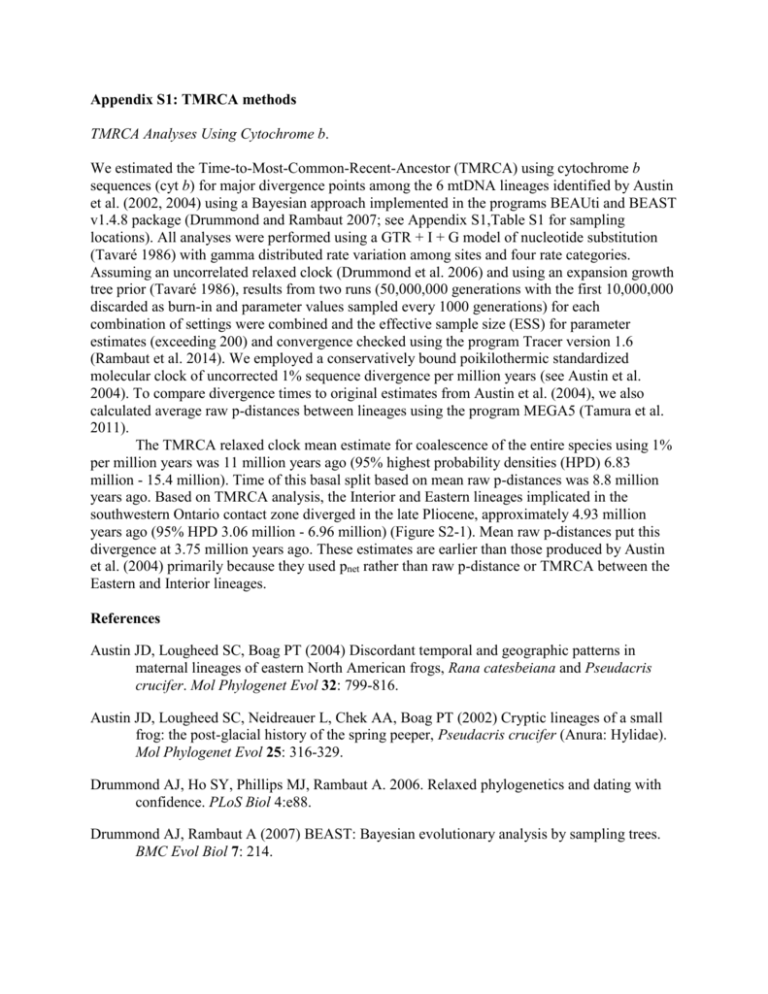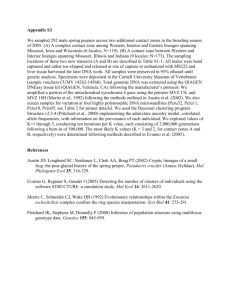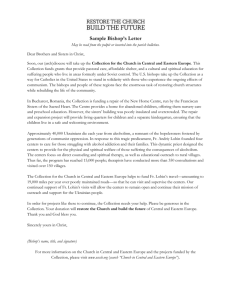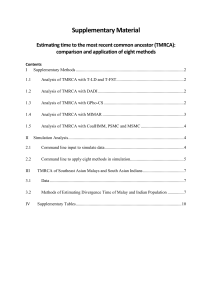Supplementary Appendix S1 (docx 214K)
advertisement

Appendix S1: TMRCA methods TMRCA Analyses Using Cytochrome b. We estimated the Time-to-Most-Common-Recent-Ancestor (TMRCA) using cytochrome b sequences (cyt b) for major divergence points among the 6 mtDNA lineages identified by Austin et al. (2002, 2004) using a Bayesian approach implemented in the programs BEAUti and BEAST v1.4.8 package (Drummond and Rambaut 2007; see Appendix S1,Table S1 for sampling locations). All analyses were performed using a GTR + I + G model of nucleotide substitution (Tavaré 1986) with gamma distributed rate variation among sites and four rate categories. Assuming an uncorrelated relaxed clock (Drummond et al. 2006) and using an expansion growth tree prior (Tavaré 1986), results from two runs (50,000,000 generations with the first 10,000,000 discarded as burn-in and parameter values sampled every 1000 generations) for each combination of settings were combined and the effective sample size (ESS) for parameter estimates (exceeding 200) and convergence checked using the program Tracer version 1.6 (Rambaut et al. 2014). We employed a conservatively bound poikilothermic standardized molecular clock of uncorrected 1% sequence divergence per million years (see Austin et al. 2004). To compare divergence times to original estimates from Austin et al. (2004), we also calculated average raw p-distances between lineages using the program MEGA5 (Tamura et al. 2011). The TMRCA relaxed clock mean estimate for coalescence of the entire species using 1% per million years was 11 million years ago (95% highest probability densities (HPD) 6.83 million - 15.4 million). Time of this basal split based on mean raw p-distances was 8.8 million years ago. Based on TMRCA analysis, the Interior and Eastern lineages implicated in the southwestern Ontario contact zone diverged in the late Pliocene, approximately 4.93 million years ago (95% HPD 3.06 million - 6.96 million) (Figure S2-1). Mean raw p-distances put this divergence at 3.75 million years ago. These estimates are earlier than those produced by Austin et al. (2004) primarily because they used pnet rather than raw p-distance or TMRCA between the Eastern and Interior lineages. References Austin JD, Lougheed SC, Boag PT (2004) Discordant temporal and geographic patterns in maternal lineages of eastern North American frogs, Rana catesbeiana and Pseudacris crucifer. Mol Phylogenet Evol 32: 799-816. Austin JD, Lougheed SC, Neidreauer L, Chek AA, Boag PT (2002) Cryptic lineages of a small frog: the post-glacial history of the spring peeper, Pseudacris crucifer (Anura: Hylidae). Mol Phylogenet Evol 25: 316-329. Drummond AJ, Ho SY, Phillips MJ, Rambaut A. 2006. Relaxed phylogenetics and dating with confidence. PLoS Biol 4:e88. Drummond AJ, Rambaut A (2007) BEAST: Bayesian evolutionary analysis by sampling trees. BMC Evol Biol 7: 214. Rambaut A, Suchard MA, Xie D, Drummond AJ (2014) Tracer v1.6. Available from http://beast.bio.ed.ac.uk/Tracer Tamura K, Peterson D, Peterson N, Stecher G, Nei M, Kumar S (2011) MEGA5: Molecular evolutionary genetics analysis using maximum likelihood, Eevolutionary distance, and maximum parsimony methods. Mol Biol Evol 28: 2731-2739. Tavaré S. (1986) Some probabilistic and statistical problems in the analysis of DNA sequences. Lect Math Life Sci 17: 57–86. Figure S1-1: Phylogeny from a Bayesian analysis of cytochrome b DNA sequence data. The analysis was done in MrBayes Version 3.2 using a GTR+I+G model of evolution. We ran two independent runs of 1 million Metropolis-coupled MCMC iterations (until the standard deviation of the split frequencies was < 0.01) with 4 incrementally heated Markov chains specifying the GTR+I+G model of evolution with parameters estimated as part of the analysis. We sampled every 100 iterations and discarded the first 25% as burn-in. We confirmed convergence by examining a plot of the log probability versus generation to ensure stationarity, and ensuring the Potential Scale Reduction Factors were all close to unity. Posterior probabilities for key nodes are shown (typically above). Estimates of divergence times in millions of years are shown: TMRCA from our Bayesian analysis in the program BEAST, and mean raw p-distance from an analysis in MEGA5, both assuming a rate of divergence of 1% per million years. Genbank Accession numbers may be found in Austin et al. (2004) save for Tex1 (KT305738) and Tex2 (KT305739). See text above for other details of analysis. Table S1-1: A. Divergence estimates (mean, standard error, median, upper and lower highest probability densities (HPD), and effective sample size (ESS)) from BEAST analysis for Time to Most Common Recent Ancestor (TMRCA) in substitutions. Divergence times were later calculated by assuming a substitution rate consistent with 1% per million years. B. Average raw p-distances calculated between lineages using MEGA5 (below diagonal) with 95% standard errors estimated from 500 bootstrap replicates (above the diagonal). See text for details. A. Nodes All Texas I/E/SE/SW Int/E/SE E/SE E I SE SW W 1.50E-3 All but Texas 4.46E-2 Mean 5.48E-2 2.9135E-2 2.47E-2 1.51E-2 2.87E-3 6.81E-3 4.21E-3 7.48E-3 1.32E-4 9.38E-6 9.05E-5 7.17E-5 5.07E-5 3.03E-5 1.15E-5 2.72E-5 1.5136E2 3.03E-5 Standard Error Median 1.68E-5 2.87E-5 5.38E-2 1.18E-3 4.33E-2 2.82E-2 2.40E-2 1.47E-2 2.68E-3 6.42E-3 1.47E-2 3.71E-3 7.09E-3 95% HPD lower 95% HPD upper ESS 3.42E-2 2.56E-5 2.85E-2 1.84E-2 1.53E-2 9.33E-3 9.49E-4 3.15E-3 9.33E-3 6.85E-4 3.58E-3 7.68E-2 3.79E-3 6.37E-2 4.14E-2 3.48E-2 2.16E-2 5.17E-3 1.14E-2 2.16E-2 8.74E-3 1.20E-2 7271.67 16739.92 11004.09 7596.95 10769.35 11944.56 10184.81 7020.04 11946.13 19995.87 6777.64 B. Interior Interior Southwest Eastern West Southeastern Texas Outgroups 0.038 0.035 0.056 0.040 0.088 0.155 Southwestern 0.007 0.052 0.060 0.051 0.080 0.161 Eastern 0.006 0.008 0.058 0.030 0.089 0.154 Western 0.009 0.009 0.009 0.066 0.080 0.158 Southeastern 0.007 0.008 0.006 0.010 0.090 0.161 Texas 0.011 0.011 0.011 0.012 0.011 0.161 Outgroups 0.012 0.013 0.012 0.013 0.013 0.013 Table S1-2: Sampling location information for individuals with unique haplotypes (Field ID – Genbank Accession numbers can be found in Austin et al. 2004) used for the construction of the Bayesian tree and TMRCA analysis tree. Field ID Tex1, Tex2 MHP8377 INHS267, 269 Pcru1289 MHP8407 MHP8375 Lineage Southwestern Western Western Western Western Western MHP8379 Western MHP8385 Western MHP8380, MHP8382 MHP8409 Western Pcru68492 Pcru1288 Pcru1864 Pcru1854 Southwestern Southwestern Interior Interior Pcru1164 Pcru1876, Pcru1880, Pcru1881, Pcru1883 Pcru1867, Pcru1870, Pcru1871 Pcru1510 Pcru1146 ECM60 PcruFL1 ECM958 Pcru1601 ECM81 Pcru57852 Pcru5575 Pcru1158 Pcru1010 Pcru1618 Pcru1886, 1887 Pcru1142 Interior Interior Location Morris Co. TX, country rd 3312, near Omaha. W311th St., Louisburg, KS N 38.5625 W 94.6691 Rte. 159, Jackson Co. IL 38°15 N 90°00 W Stone Co. AR ca. 1 mi W Bluff City, Fayette Co. IL 38.962,-89.059 2 mi S jct St rte Y and MO Rt 215 on unnamed country road. N37.5216 W93.7415, Dade Co. MO 4.5 mi. N Pere Marquette State Park on Ill Rt. 100, Dabbs Study Area, IL 10 km NW Winchester, E of Ill Rt. 100 and 1.6 km S jct US Rt 67 and I 72; SE Sec 27, T14N, R13W, Scott Co. IL 4.5 mi. N Pere Marquette State Park on Ill Rt. 100, Dabbs Study Area, Jersey Co. IL 4.8 mi E Coffeen, 0.3 mi E. Oak Trail Road on Ill Rt. 185, Montgomery Co. IL Salem, Pearl River, MS, 30°290 N 089°360 W White Co. AR Big Bend Conservation Area, Ontario 42.644, -81.705 Melbourne R., South of Strathroy, ON (RR between Century and Falconbridge Roads. 42°51.310 N 81°36.260 W Murfreesburo, Rutherford, TN 35°500 N 086°240 W Moore Habitat Management Area, Ontario 42.767, -82.336 Interior Mosa Forest Conservation Area, Ontario 42.644, -81.809 Interior Interior Southeastern Southeastern Southeastern Eastern Eastern Eastern Eastern Eastern Eastern Eastern Eastern Eastern Danville, Virmillion, IL 40°110 N 087°440 W Long Point, Haldimand-Norfolk, ON 42°370 N 080°280 W Barnwell, SC 33°180 N 081°150 W Ocala, FL 29°100 N 082°200 W Macon Co. GA N32.44951 W85.65438 Beech Fork State Park, Wayne Co., WV Pitt NC 35°350 N 077°230 W Dawn, Caroline, VA 37°390 N 077°170 W Ottawa, ON 45°190 N 075°480 W Innisfil, Simcoe, ON 44°220 N 079°360 W Sherry Township, WI 44°150 N 090°050 W Aberfoyle, Wellington, ON 43°290 N 080°090 W Dundas, Hamilton—Wentworth, ON 43°140 N 080°010 W Long Point, Haldimand-Norfolk, ON 42°370 N 080°280 W Western







